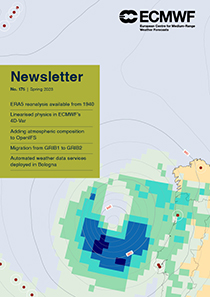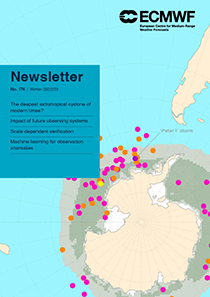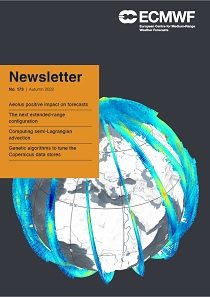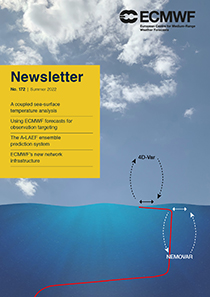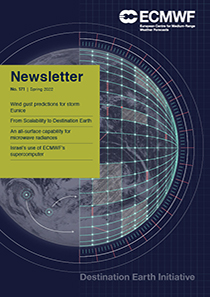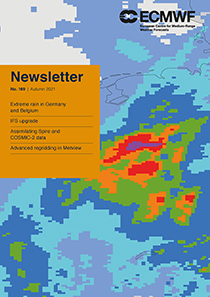ECMWF Newsletter
Subscribe to email alerts for Newsletters (unsubscribe)
Featuring
- An update on AI–DOP: skilful weather forecasts produced directly from observations
- Modernisation of the Integrated Forecasting System
- Twenty years of the Framework for Member State time-critical applications
- ECMWF Sites: websites as a service
Featuring
- IFS upgrade improves near-surface wind and temperature forecasts
- Improving the physical consistency of ensemble forecasts by using SPP in the IFS
- Data-driven ensemble forecasting with the AIFS
- The Copernicus Interactive Climate Atlas: a tool to explore regional climate change
Featuring
- Destination Earth’s digital twins and Digital Twin Engine – state of play
- Introduction of a new ocean and sea-ice model based on NEMO4-SI3
- ECMWF’s next ensemble reanalysis system for ocean and sea ice: ORAS6
- The European Weather Cloud is now operational
Featuring
- Ocean-wave-related changes in the next model upgrade
- A new time-varying tropospheric aerosol climatology for the IFS
- Medicane Daniel: an extraordinary cyclone with devastating impacts
- Introducing earthkit
Featuring
- New group formed to protect spectrum for meteorology and Earth observation
- Improved two-metre temperature forecasts in the 2024 upgrade
- Red sky at night... producing weather forecasts directly from observations
- On-demand web plotting of observation monitoring statistics
Featuring
- Combining machine learning and data assimilation to estimate sea ice concentration
- What next for Magics visualisation?
- Thirty years of the ecgate service at ECMWF
- Running a Global Broker as part of the new WMO data sharing solution
Featuring
- IFS upgrade brings many improvements and unifies medium-range resolutions
- Interaction between polar and subtropical jet streams over Greece, 7–10 July 2022
- WIS 2.0: WMO data sharing in the 21st century
Featuring
- Linearised physics: the heart of ECMWF’s 4D-Var
- Enhancing OpenIFS by adding atmospheric composition capabilities
- Migration from GRIB1 to GRIB2: preparing ECMWF model output for the future
- Automated weather data services deployed in Bologna
Featuring
- Predicting the forecast impact of potential future observing systems
- Scale-dependent verification of precipitation and cloudiness at ECMWF
- Use of machine learning for the detection and classification of observation anomalies
Featuring
- Aeolus positive impact on forecasts with the second reprocessed dataset
- The next extended-range configuration for IFS Cycle 48r1
- A new way of computing semi-Lagrangian advection in the IFS
- Using genetic algorithms to tune the Copernicus Climate and Atmosphere Data Stores
Featuring
- Progress on developing a new coupled sea-surface temperature analysis
- Using ECMWF ensemble forecasts for operational observation targeting
- The mesoscale ensemble prediction system A‑LAEF
- ECMWF’s new network and security infrastructure
Featuring
- From the Scalability Programme to Destination Earth
- Developing an all-surface capability for all-sky microwave radiances
- Israel uses ECMWF supercomputer to advance regional forecasting
Featuring
- ECMWF’s support for the SEE-MHEWS-A project
- ECMWF’s new data centre in Italy
- Aviso: ECMWF’s data availability notification service
- New Python data exploration functions in Metview
Featuring
- IFS upgrade improves moist physics and use of satellite observations
- Assimilating Spire and COSMIC-2 data into the IFS
- Advanced regridding in Metview
Looking for past newsletter issues? Find all issues in our library

